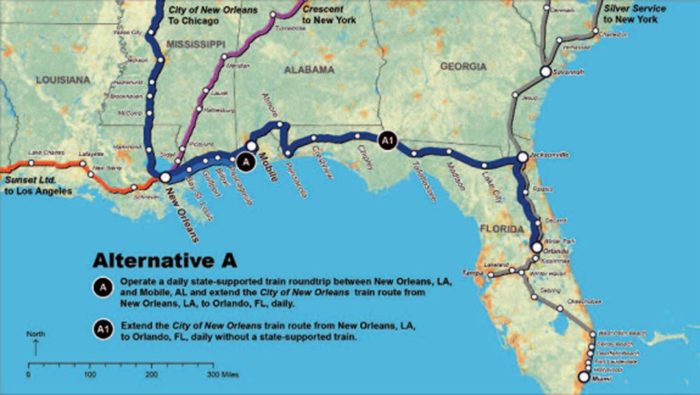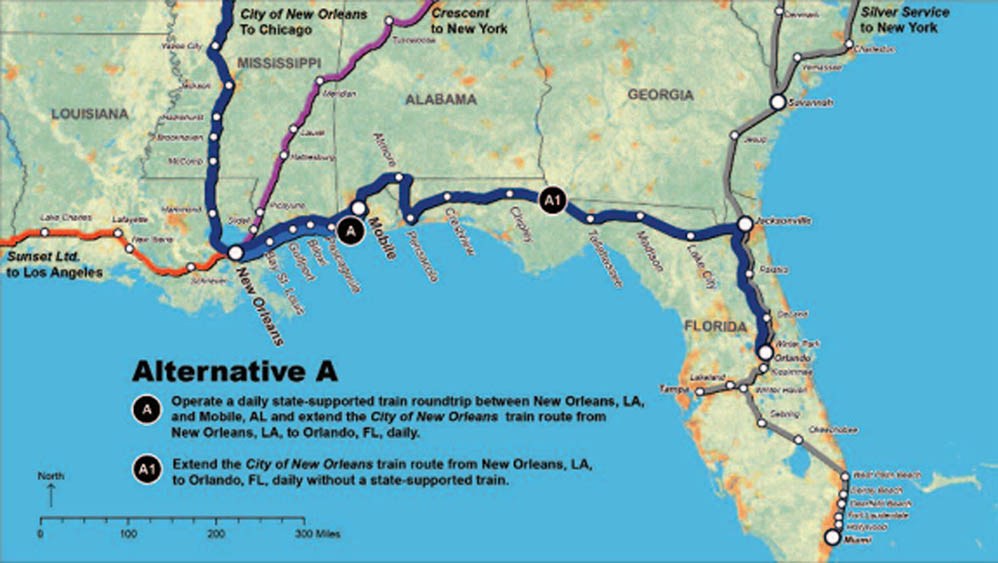A Daily Train for the Gulf Coast?
There are some notable gaps in Amtrak’s long-distance routes that make taking the train from Point A to Point B inconvenient or expensive or both. The most obvious example is travel from New Orleans to Florida. This was a do-able trip until 2005 when Hurricane Katrina wiped out a lot of track east of New Orleans. The track was repaired literally within months, but—alas—the three-days-a-week Sunset Limited service has never been restored.
For the past dozen years, the only practical option for travelers going between New Orleans and anywhere in Florida has been by air. A rental car could get you from New Orleans to Orlando, but it would take about 11 hours of actual driving. Certainly the train is the most comfortable way to go, but the first night would be aboard the Crescent to Washington, connecting with the Silver Star for another overnight ride south to Orlando. And the fare? About $750 for sleepers.
No wonder there has been increasing agitation for restoring that portion of the Sunset Limited’s route east of New Orleans, passing through Mobile, Alabama, and Florida’s capital city, Tallahassee, en route to Jacksonville and Orlando.
To that end, the Southern Rail Commission was formed to study how best to bring passenger rail back to the Gulf Coast. The commission came up with no less than five possibilities. Amtrak then generated ridership estimates for each and those were finally made public near the end of last year.

The best option—which actually would increase frequency between New Orleans and Orlando from three times a week to daily service—would be achieved by extending the route of trains 58 and 59, the City of New Orleans. It would become a two-night trip from Chicago through New Orleans to Orlando. As attractive as that sounds, and despite all the enthusiasm from public officials representing cities and towns along the proposed Gulf Coast route, the new service is by no means a slam dunk.
The fact is, the Sunset Limited’s three-times-a-week service was better than nothing, but not by much. The biggest problem was an awful on-time performance—hardly a surprise for a 2,800-mile route, two-thirds of which was over track owned by Union Pacific, considered to be the most Amtrak-unfriendly of all the major freight railroads. Poor on time performance and the three-times-a-week schedule had a detrimental effect on ridership and that, of course, hurt the train’s bottom line, already adversely affected by still more questionable Amtrak accounting.
The big question—in fact, it’s virtually the only question—is what’s the proposed service going to cost and who’s going to pick up the difference between that number and income from the fare box. There are some positive signs. The mayors of all those towns along the proposed route are on board. Mississippi’s governor, Phil Bryant, is on board. A number of the members of Congress—including some Republicans, no less!—seem favorable. And NARP members turned out in force to greet a special train following that very route.
What’s next? I guess it will be when Amtrak says they’re ready to run the City of New Orleans every day all the way to Orlando, but the estimated subsidy is going to be X-dollars. The good news is that the money would come from four states: Louisiana, Mississippi, Alabama and Florida, plus no doubt all the cities and towns along the way would be asked to make a contribution. There’s even logic to expecting some private capital because a daily train would certainly provide a push to local economies all along the way.
The thing is, it shouldn’t be this complicated! What if Florida says it won’t participate? Would the other three states pick up Florida’s share. Not likely. And that’s why Amtrak should be supported with an adequate subsidy from the federal government. Better yet, a dedicated source of funding Amtrak can count on year after year. Clean. Simple. Makes sense.




So now being 2022, and after all this, when is service from Tampa, Florida to New Orleans, by rail going to start running, Don’t really want to go north to DC or Chicago to go out west to California via New Orleans, across the southern US.
You are quite right. There is no legitimate reason why this service has not been restored. Only the refusal of the freight railroads to make it happen stands in the way. Support the Rail Passengers Association in their efforts to rectify this outrage. To visit my sister in Florida, I have to get to Washington, then Amtrak south to Orlando, then back to Washington, then down to New Orleans (probably 4-5 hours late arrival), then to LA on the Sunset Limited. All because–despite the clear intent off the law–the freight railroads will not allow it.
You said in your article “What if Florida says it won’t participate? Would the other three states pick up Florida’s share” but my understanding is that Alabama is actually the problem. If you look on the map picture in your article and see the small town called Chipley west of Tallahassee, I live just 20 minutes south of there. Yes I showed up for the “special train”. As far as I know all our federal politicians in Florida are on board with restoring the Gulf Coast service. I can hardly wait.
That’s the fundamental problem with the law Congress passed. It shoves the financial burden for routes of 750 miles or less off onto the states. And if one state won’t share in the cost, the other states are faced with a difficult and unfair choice–to pay what should have been the fair share of the other state’s taxpayers.
Thanks, Jim
I just looked up the Orange Blossom Special on Wikepedia. I think a comparison of sorts is made with Amtrak’s Silver Star, wouldn’t you say?
“ Our chef…spent nine of his forty-three years with the Pennsylvania Railroad as chef on the celebrated all-Pullman New York-to-Florida train the Orange Blossom Special—the most luxurious winter-season train ever devised by man. Nothing even remotely resembling a can opener was allowed on the premises. All the pies, cakes, rolls, birthday cakes were baked on board under his supervision. Cut flowers and fresh fish were taken on at every revictualing stop, and the train carried thirty-five hundred dollars’ worth of wine, liquor and champagne—these at pre-Prohibition prices—for each run. ”
The service was suspended during World War II to free the equipment up for carrying troops. Its last run was in 1953. This market is now handled by Amtrak’s Silver Star.
Nothing wrong with the City of New Orleans Chicago to Florida route I suppose, but speaking of route gaps I did start wondering about the history of a more direct route from Chicago to Florida that might include at least two cities not now served by Amtrak.
Looking at the map, it would seem a Chicago-Indianapolis-Louisville-Nashville-Atlanta-Florida route would be most direct and serve several population centers. Did Amtrak, or a pre-Amtrak company, ever run a route like that, or are there some geographical barriers (such as perhaps the Appalachian mountains between Nashville and Atlanta) to such a route?
This is not my area of expertise because I was living in Hawaii from the early 60s, but I believe there was a Chicago-Florida train in pre-Amtrak days called the South Wind. The route was inherited by Amtrak and they ran the train from 1971 until 1979. There were other trains to Florida–the Orange Blossom Special was one–buy I think they originated from New York.
I’ve heard CN is even worse than UP in relationship to passenger trains it hosts on it’s rails, but UP is not very interested in passengers, it seems.
Well, I hope for you, and for all those people enthusiastically awaiting the train in Mobile, Tallahassee and the likes, that train will resume service soon…
We are cautiously optimistic.
This is exactly the reason why Amtrak should be converted to a public transit system as I stated a few posts back. And in this case, a possible court decision could force service to happen if it is shown that bus service doesn’t serve the small cities along this route and air service probably provides less more inconvenient service in this region as well.